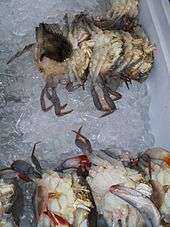Soft-shell crab

Soft-shell crab is a culinary term for crabs which have recently molted their old exoskeleton and are still soft.[1] Soft-shells are removed from the water as soon as they molt to prevent any hardening of their shell. [2]This means that almost the entire animal can be eaten, rather than having to shell the animal to reach the meat.[3] The exceptions are the mouthparts, the gills and the abdomen, which must be discarded.[4] The remaining, edible part of the crab is typically deep fried or sautéed.[3]
In the United States, the main species is the "blue crab," Callinectes sapidus, which appears in markets from April to September.[5]
In Japan, various species are used to make sushi such as maki-zushi or temaki-zushi.[3] The Japanese blue crab (Portunus trituberculatus) or the shore swimming crab (Charybdis japonica) is typically used.
In Italy, the soft-shell of the common Mediterranean crab is a delicacy typical of the Venetian lagoon (called moeca in the local idiom).[6]
See also
- List of crab dishes
- List of seafood dishes
-
 Food portal
Food portal
References
| Wikimedia Commons has media related to Soft-shell crab. |
- ↑ CiCi Williamson, Garry Pound & Willard Scott (2008). "Shellfish and fish". The Best of Virginia Farms Cookbook and Tour Book: Recipes, People, Places. Menasha Ridge Press. pp. 60–87. ISBN 978-0-89732-657-5.
- ↑ Thompson, Fred (2010). Crazy for Crab: Every Thing You Need to Know to Enjoy Fabulous Crab at Home. ReadHowYouWant.com. p. 7. ISBN 978-1-45876-388-4. Retrieved 15 January 2015.
- 1 2 3 Ole G. Mouritsen (2009). "Sushi à la carte". Sushi: Food for the Eye, the Body and the Soul. Springer. pp. 202–250. ISBN 978-1-4419-0617-5.
- ↑ Tracy Barr (2011). "Soft-shell crabs". Cast Iron Cooking For Dummies. John Wiley & Sons. pp. 137–138. ISBN 9781118053188.
- ↑ Delilah Winder & Jennifer Lindner McGlinn (2006). "Fried soft-shell crab". Delilah's Everyday Soul: Southern Cooking with Style. Running Press. pp. 111–112. ISBN 978-0-7624-2601-0.
- ↑ "Moeca (soft-shell crab)". Parco Alimentare Venezia Orientale. Retrieved January 19, 2011.